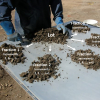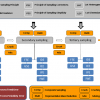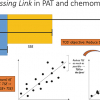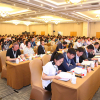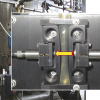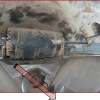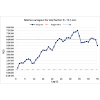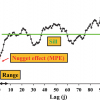Sampling Columns
The sampling of particulate matter is all too often performed without consideration of the importance of representative sampling and the Theory of Sampling. This second part compares grab sampling with composite sampling further illustrating this important issue, and again using the example of contaminated soil which often has a very complex nature.
Sampling particulate matter is in many fields performed without a scientific basis, mostly because its critical role is ignored, or at best, misunderstood, and because of an unawareness of, sometimes a disregard for, the Theory of Sampling. This two-part column illustrates this important point using experience in the field of geo-environmental engineering.
Previous Sampling Columns have dominantly focused on the technical issues of representative sampling. This column addresses sampling from the complementary point of view: “What is the economic and commercial impact from non-representative sampling on management decisions and in boardrooms?” We have invited two experienced business consultants to help scope out an outline indicating powerful opportunities for added value and for substantial savings.
Kim Esbensen outlines questions you should ask before buying any sampling equipment, and points out areas of responsibility.
Kim Esbensen has, in his Sampling Column, been alerting us all to the dangers of ignoring sampling and explaining how to use the Theory of Sampling (TOS) to ensure correct and representative sampling. In this issue, he, with the help of Paul Bédard from the Université du Québec à Chicoutimi, shows one way in which students can be introduced to the TOS and the problems of ignoring heterogeneity in sampling. Paul Bédard has developed a simple sampling exercise based around floor tiles (see front cover) to provide his geoscience students with practical experience.
The Sampling Column points out that incorrect sampling is irreversible: no amount of chemometrics or further samples will be able to produce a valid model if the sampling is not representative. This applies in flowing PAT analyses as much as in static.
This column shows how well the Theory of Sampling is able to address the powder sampling difficulties that have plagued the pharmaceutical industry for a long time. Definitely, a practical example of the importance of representative sampling.
Here starts a second round of Sampling Columns, which have been a fixture in almost every Spectroscopy Europe issue since its inauguration in 2014. The first series, which concluded in the last issue, provides a stand-alone collection for easy, free access to a first curriculum of the Theory and Practice of Sampling. The second series of Sampling Columns will focus on sampling in practice, special issues and features (left out of the first series), educational gems and other bits-and-bobs. The last two items comprise a mixture of topics and issues that also will illustrate and educate readers, but specifically only after a first minimum of TOS competence has been acquired
A report on the 9th World Conference on Sampling and Blending (WCSB9), held in Beijing from 7–9 May 2019.
This column concludes the first series of Sampling Columns. More will appear in a sequel series, mainly aimed at presenting practical examples, case histories, demonstrations—all of which will assume that the value of only practicing representative sampling has been fully acknowledged and the relevant know how has been comprehended. Here, we end the first educational exposé of the Theory of Sampling (TOS) by focusing on the current state of awareness and with an acknowledgement of the need to involve TOS in all relevant international scientific fora, in technology, industry and in the commercial marketplace.
This column completes the tale of two fictional laboratories both facing the issue: “How can the Theory of Sampling (TOS) help the commercial laboratory to improve its reputation and to increase its business”?
Kim Esbensen challenges commercial laboratories to add primary sampling to their range of responsibilities. Kim’s “tale” of two fictional laboratories should certainly provoke some comment, and concludes in the next issue.
The story of Pierre Gy, who founded the Theory of Sampling (TOS), is a remarkable one, and his work is still the basis of representative sampling today.
The last sampling columns have focused on the advantages the Theory of Sampling (TOS) can bring to companies, producers and manufacturers significantly reducing costs due to inferior sampling, and maximising efficiency and logistics. Here instead we take a look at sampling from the point of view of buyers, consumers and from a broader societal perspective, exploring the economic benefits and other advantages (e.g. transparency) that can be obtained through proper sampling. We address the point of view of the ultimate users and beneficiaries of TOS, on the market place or elsewhere. We are going to explore the other side of the coin, the one linked to the ethical and moral obligations that pertain to decision-makers of responsible public and governmental bodies, which indeed should apply equally also to producers and manufacturing companies.
Pentti Minkkinen and Kim Esbensen present case histories and examples all focusing on the potential for economic loss or gain—by following, or more importantly, by not following TOS.
Sampling takes place every day in everybody’s daily life. Consciously or unconsciously, we all take decisions regarding how to select and collect the things we need, be those vegetables or coffee in the supermarket, or material for academic research projects—with everything in between. Those who have been curious enough to reflect on everyday decision-making processes, discovered immediately that sampling decisions often make all the difference. This is why an incipient theory started to be elaborated. One individual, more brilliant than others, made a giant step forward in the evolutionary thinking on sampling and developed what became the Theory of Sampling (TOS); his name was Pierre Gy. Here, we discuss cases both pro et contra TOS.
Karin Engström, LKAB mining, Kiruna, Sweden, continues to present illuminative cases from process industry. Here she reveals more from her ongoing PhD project showing application of variographic characterisation for on-line continuous control of process sampling systems, including the one that was validated according to current ISO standards guidelines in the previous column (monitoring a particular iron ore pellet stream). Together, the cases presented constitute a broad didactic showcase of the power of variographic analysis and problem-specific interpretations.
This feature forms an intermezzo in the current segment of process sampling columns. We have asked Karin Engström, Luossavaara Kiirunavaara AB (LKAB), Kiruna, Sweden to outline how industrial validation of a process sampling system takes place following ISO standards guidelines.
Pierre Gy, the inventor of the Theory of Sampling (TOS), pioneered applications of variography to understanding large-scale variability in process plants and process control from as early as the 1950s and devoted a major part of his TOS development period to this subject. The variogram allows one to identify sources of variability and provides valuable insight into correlations between successive samples. Neglect or poor understanding of the data analytical capabilities of the variogram means that it has not been widely applied in process control until now, except in industry sectors which have embraced TOS (mining, cement and certain parts of the process industries) because of the overwhelming consequences of making wrong decisions when treating vast tonnages—the consequences of wrong decisions are simply too great. Failure to address stream heterogeneity means that conventional statistics and Statistical Process Control (SPC) too often fail to identify and distinguish the true sources of variability in a process stream. For each type of heterogeneity, there is a matching variety of process variability. Although the method is powerful in terms of the insights one is able to gain in regard to plant performance and management, examples of the application of this particular method have been suspiciously little notable in the literature.
After the previous column’s introduction to the why, the how and the technicalities involved in process sampling and variographic analysis, it is time for a bonanza of applications and case histories covering as broad a practical scope as possible. In this column, we introduce the critical prerequisites for the variographic experiment, by focusing on the importance of TOS-correct increment extraction for proper variographics. This issue cannot be overemphasised.

